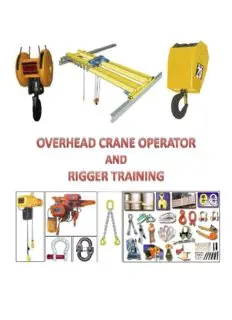
Overhead Crane Operator Training Handbook PDF
Preview Overhead Crane Operator Training Handbook
OVERHEAD CRANE O?lERAiOR D IA RiGGiER TRA~N~NG Table Of Contents Subject Matter Page Overhead Crane Operator/ Rigger Training Course Objectives 1 Rigging Terminology 3 The Riggers Worksheet 11 Rigging Safety Video and Quiz 15 Wire Rope Slings - Use, Care and Inspection 17 Chain Slings - Use, Care and Inspection 29 Nylon Slings – Use, Care and Inspection 35 GSFC- Revised Policy on the use of Turnbuckles (February 2002) 55 How to Read Sling Manufacturers Charts 61 (Using the CROSBY Users Guide To Lifting) Load Weight Estimation and Rigging Selection Exercises 65 Common Rigging Problems 71 The Rigging Plan 81 OSHA 1910.184 Slings and Rigging 93 NASA STANDARD 8719.9 129 (Excerpts from Sections 10.0 to 10.7 - Rigging) Common Overhead Crane Terminology 141 Do’s and Don’ts Of Overhead Crane Operation 147 OSHA 1910.179 Overhead and Gantry Cranes 153 (Excerpts from Inspection and Operation sections) NASA STANDARD 8719.9 (Excerpts from Section 1 Through 3 ) 165 NASA STANDARD 8719.9 (Excerpts from Section 4 ) Overhead Cranes 181 Goddard Procedural Requirement GPR 8834.1B 191 Hydra-Sets 219 Load Measuring Devices 233 Goddard Procedural Requirement GPR 8719.1B 243 Overhead Crane Safe Operation Video and Quiz 269 Violations- Let me count the Ways (Exercise recognizing violations) 271 Pre-Operation Inspection of Overhead Cranes and Hoist 273 Operating With A Radio Control 293 Communication – Standard Hand Signal 303 Additional Emergency Operating Procedures for Crane Operators and Operations 311 Mishaps and Close Calls (This section will be added to as Mishaps or Close Calls occur) 319 This page intentionally left blank Overhead Crane Operator / Rigger Training Course objectives 1. Given any selected overhead crane, the trainee will be able to perform a pre-operational inspection of the crane . 2. Given the basic requirements for a lift, the trainee will be able to plan a lift such that it can be accomplished efficiently, safely, and in complete accordance NASA STD 8719.9, Goddard Space Flight Center (GSFC) GPR 8834.1, (GSFC) GPR 8719.1, OSHA 1910.179, and ANSI B30 Standards. 3. Given any selected overhead crane, the trainee will be able to perform crane operation efficiently, safely, and in complete accordance NASA STD 8719.9, (GSFC) GPR 8834b, (GSFC) GPR 8719.1, OSHA 1910.179, and ANSI B30 Standards. 4. Given a sample load composed of multiple elements of mixed shapes and densities, trainee will be able to correctly determine total weight within +/- 5%. 5. Given a sample load composed of multiple elements of mixed shapes and densities, trainee will be able to correctly determine the center of gravity (CG) of the load within 6”. 6. Given load parameters and lift conditions for typical lifts, the trainee will be able to properly select the rigging for each case based upon weight, dimensions, weight distribution, and type of load, temperature, and chemical influences. 7. Given examples of any of the rigging components commonly used, the trainee will be able to visually inspect those components and detect errors. 8. Given a drawing and specifications for a lifting assembly, the trainee will be able to select the proper components and assemble them accordingly. 9. Given a sample load and correct rigging components, the trainee will be able to rig the load for a lift efficiently, safely, and in complete accordance NASA STD 8719.9, Goddard Space Flight Center (GSFC) GPR 8834, (GSFC) GPR 8719.1, OSHA 1910.184, and ANSI B30 Standards. 10. Given a fully rigged load, the trainee will be able to perform the lift as a crane operator and as a rigger as part of a lift team using proper methods and communication. 1 of 332 This page intentionally left blank 2 of 332 Rigging Terminology Lets first look at some common components used in rigging and lifting operations. Wire Rope Slings Wire Rope Thimble Protects Wire Rope Sling Eye from being damaged or worn. Chain Slings Synthetic Rope Sling 3 of 332 Rigging Terminology Nylon Slings Type 1 : Triangle & Choker (TC) - Hardware on each end produces the most effective choker hitch. Can also be used in vertical and basket hitches. Type 2 : Triangle & Triangle (TT) - Hardware on each end for use in basket or vertical hitch. Type 3 : Flat Eye & Eye (EE) - Popular, versatile sling used in vertical, choker & basket hitches. Easy to remove from underneath loads. Type 4 : Twisted Eye & Eye (EE) - Eyes turned at a right angle to sling body. Forms superior choker hitch & allows better fit on crane hook in basket hitch. Type 5 : Endless (EN) - Economical & adaptable sling with no fixed wear points. Used in all hitches. Type 6 : Reversed Eye (RE) - Extremely strong & durable for continuous &/or abusive applications. Wear pads on both sides of body. Hoist Rings 4 of 332 Rigging Terminology Synthetic Round Slings Shackles Not to be used for any angular Lifting Due to the angular lifting properties of most lifts GSFC recommends not using this type for any overhead lifting Shouldered Eye Bolts Not to be used for any overhead Lifting Due to properties of Un-Shouldered Eye Bolts the use of this type of Eye Bolt is forbidden at GSFC for any overhead lifting 5 of 332 Rigging Terminology Pear Rings Oval Rings Turnbuckles Spreader Bars Can Only be used in a Straight Line Lift Hooks & Safety Latches 6 of 332
